The following is a list of 14 African Hardwoods along with their various qualities and how they are commonly used:
1. African Blackwood / Grenadillo
Dalbergia Melanoxylon

Family: Leguminosae
Other Names: Congowood, Mozambique ebony, Senegal ebony Cape Damson ebony.
Distribution: This African tree has an extensive range on the continent.
It can be found in the savanna regions of Sudan southward to Mozambique, then westward to Angola and northward to Nigeria and Senegal.
The Tree: This small tree is about 30 ft. (9.1 m) maximum height, and a diameter of 8 in. (203mm).
Trees of this species average 50 to 60 ft. (15.2 to 18.3m) tall and with a diameter of 1’-8” (50cm) and up.
The Timber: the heartwood is dark purplish-black or brown with black streaks which usually predominate so that the general effect is nearly black.
The luster is dull and odor and taste are not distinct.
It is very hard and heavy wood with a weight of 82 lb/ft 3 (1,314 kg/m 3 ). The grain is mostly straight with a fine texture.
It has a slightly oily nature. The narrow sapwood is white and very clearly defined.
Seasoning: Blackwood dries very slowly and tends to split, especially in the log. It is advisable to coat the ends to minimize the splitting.
Once dried, the timber is slow to absorb moisture.
Durability: The heartwood is said to be very durable.
Working Qualities: This wood has exceptionally good working qualities. It cuts very smoothly and evenly, taking an excellent finish directly from the tool of the drill or lathe.
It can be tapped for screw threads almost like metal. It is considered to be the best wood available for ornamental turnery.
Uses: A chief use is for woodwind instruments such as flutes, clarinets, bagpipes, etc. It is superior to ebony for this purpose because of its oily nature and resistance to climatic changes.
The wood is also used for turnery in making such items as brush backs. Knife handles, chessmen and pool cues.
2. Afzelia
Afzelia quanzensis
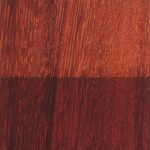
Family: Leguminosae (legume)
Other Names: Pod-Mahogany, mahogany bean, chanfuta, peulmanhonia, mkehli.
Distribution: The species Afzelia can be found in the West, Central, and East African regions of sub-Saharan Africa.
The species A. quanzensis is distributed in both lowland rain and dry forest and savannas in the coastal belt of eastern Africa from Kenya to Mozambique and South Africa.
The Tree: This is a very large and spreading tree reaching heights of 70-80 ft (21-24m). However, its straight bole rarely exceeds 12-20 ft (3.7-6.1m). Its diameter can swell to 4 ft (1.2m) in ideal growing conditions.
The greenish-gray bark tends to flake in circular patches giving the tree a distinctive pitted effect.
The leaves are alternate, compound, with 4-6 pairs of opposite or nearly opposite oblong-elliptic leaflets. The fruit is a large, flat, dark brown, thickly wooded pod.
Embedded in a white pith inside the pod are 6-10 distinctive dark blackish-brown seeds. The seeds are used for necklaces and sold as curios.
The Timber: It is light-colored when freshly sawn and turns to a rich reddish-brown when exposed to the air.
It has the appearance of a dense grade of a beautiful mahogany (Swietenia spp.). The texture is medium to coarse with an interlocking grain. Afzelia weighs 47-50 lb/ft3 (753-801 kg/m3).
It is obtainable in wide boards but the lengths are generally short. It lacks a characteristic taste or odor.
The wood is related and somewhat similar to the Intisia spp., a testimony to its beauty and usefulness.
Seasoning: Afzelia is stable when seasoned. It dries slowly with very little or no degradation.
Durability: The wood is very durable and moderately resistant to termite attacks.
As with many other kinds of wood, the sapwood is vulnerable to power post beetles.
Its real glory is that it is resistant to the teredo in maritime applications.
Workability: Because this wood is relatively hard, all tooling for its machining must be appropriate and cutting edges sharp and angled properly. Its interlocking grain may be troublesome. It finishes well and takes a high polish.
Uses: This high-strength and durable timber is used for high-class joinery in both indoor and outdoor applications.
It is especially attractive when used for doors, window frames, floors, and staircases.
In its native locale, it is a favorite for highly ornamental carved doors and chests.
3. Burkea
Burkea africana
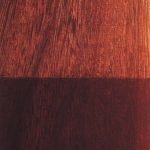
Other Names: Mucarala, mgando, maccarati, siri.
Distribution: The species Burkea africana can be found in East African regions of sub-Saharan Africa.
The Tree: The tree grows to a height of 50-70 ft (15.2-21.3m), with a diameter of 12-24 in. (30-61mm) with boles that average 15-20 ft (4.6-6.1m) in length.
The Timber: The heartwood is of variable reddish-brown color, with darker longitudinal stripes.
Figure with slight traces hardly visible. Moderately lustrous. It has an interlocked grain and a fine to medium texture.
Seasoning: Dries well but with a slight tendency to splitting and distortion. The wood is dimensionally stable after seasoning and retains its shape well.
Durability: Durable; resistant to insects and fungal attack. Heartwood has a high natural resistance to decay in contact with the ground. Moderately permeable to preservative treatments.
Workability: Somewhat difficult to saw and plane giving a rather rough surface. Sands well. Resistant to nailing, pre-boring required. Takes polish and varnish well.
Uses: Used as structural beams in construction, marine timber, and for carpentry. Also recommended for decorative plywood, furniture, kitchen cabinets, and flooring.
4. Chacate
Guibourtia conjugata
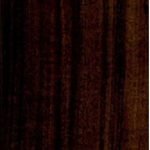
Family: Leguminosae (legume)
Other Names: Chacate preto.
Distribution: Mozambique and South Africa.
The Tree: Smaller than most of its close relatives (Bubinga), chacate still attains a height of about 90 ft (27m) and diameters usually in the range of 20-30 in. (51-76cm) range.
Clear boles are attainable up to 40 ft (12m) in length.
The Timber: The heartwood is dark brown near black with lighter honey brown longitudinal streaks. Moderately lustrous. Its grain is interlocked and fine-textured.
Seasoning: Moderately easy to dry despite its density.
Durability: Very resistant to fungal and insect attacks.
Workability: Chacate saws and planes rather easily. Sands to a smooth finish. It cannot be nailed or screwed without pre boring. Glues well. Good for varnishing and polishing.
Uses: Special furniture, turnery, and carving.
5. Copalwood
Guibourtia colesperma
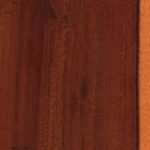
Family: Leguminosa
Distribution: Central and East Africa.
The Tree: This tree reaches a height of 50-60 ft (15-18m0 with a diameter of 18-24 in. (30-50cm) and a bole of 25-40 ft (8-12m).
The Timber: The sapwood is yellowish-white in color and clearly demarcated from the heartwood.
Heartwood is pinkish-brown with darker streaks. The heartwood color ages to a rich mahogany reddish-brown with the streaks less obvious.
The grain is interlocked and less figured than Bubinga (Guibourtia demeusei). The wood has a moderately fine texture.
Seasoning: Dries very slowly and requires care to avoid surface checking, but generally the degradation is minimal. The wood is stable in use.
Durability: Very durable; very resistant to fungal and insect attack. Sapwood is moderately permeable to preservative treatments and heartwood extremely resistant.
Working Qualities: The timber works fairly easily with both hand and machine tools.
A reduction in the cutting angle to 15 degrees is advisable to avoid picking up in machine planing, especially when the timber has interlocked grain. Takes a high varnish and polish.
Uses: Used principally for furniture, flooring, veneer and decorative constructions.
6. African Mahogany
Khaya nyasica
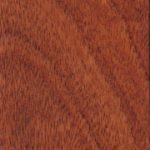
Family: Meliaceae (mahogany)
Other Names: Acajou, umbaua, grand bassam.
Distribution: Tropical West, Central, And East Africa.
The Tree: A large tree up to 190 ft (58m) high and 20 ft (6.1m) in girth, with an average exploitable girth of 11-12 ft (3.4-3.7m). It is heavily buttressed and has a long clear bole.
The Timber: The wood is medium hard and of medium weight and ranges between 32 lb/ft3 – 45 lb/ft3 (513-721 kg/m3) averaging 42 lb/ft3 (673 kg/m3) when green. It is pink when freshly cut, darkening to a reddish-brown, with pale golden-brown zones, on exposure. The sapwood is yellowish-brown in color and is up to 2 in. (51mm) in width and it is not always distinctly demarcated from the heartwood. The grain is sometimes straight, but generally interlocked, giving a characteristic stripe figure in quarter sawn stock. The texture is medium to coarse, but even. It has no distinct taste or odor. The planed surface is lustrous. Growth rings fairly distinct to the naked eye due to the presence of terminal parenchyma.
Seasoning: Dries rapidly with little degrade. Small movement in service.
Durability: Durable; resistant to fungal and insect attack. Sapwood is moderately permeable to preservative treatments and heartwood extremely resistant.
Workability: The timber works fairly easily with both hand and machine tools. A reduction in the cutting angle to 15 degrees is advisable to avoid picking up in machine planing, especially when the timber has interlocked grain. Nails well, slightly resistant to screws. Glues well. Takes a high polish.
Uses: Very suitable for veneer and plywood. Also suitable for furniture and carpentry.
7. Mecrusse
Androstachys johnsonii
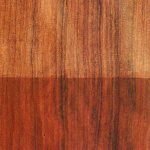
Family: Euphorbiaceae
Other Names: Muave, muari, mucuruco.
Distribution: The tree is an East African wood occurring southwards from Tanzania to the northern part of South Africa.
The Tree: The tree grows to a height of 100 ft (30m) with a diameter of 2-3 ft (60-90cm). It develops a straight bole that is often clear of branches for the first 50 ft (15.24m).
The Timber: The sapwood is yellow-white in color and is not sharply demarcated from the heartwood. Heartwood light brown or brown sometimes slightly pink or reddish tinge with darker markings.
Growth rings distinct and wavy causing a fine streaked figure. Medium lustrous. Its grain is wavy and irregular, but sometimes straight. Very fine texture.
Seasoning: Dries slowly with a tendency to surface checking. Medium movement in service.
Durability: Very resistant to fungal and insect attack including termites. However, standing trees are liable to attack by fungus which damages the structure of the wood. Very difficult to treat with preservatives.
Workability: Hard to saw and plane. It cannot be nailed or screwed without pre boring. Glues well and can be sanded to an excellent finish. The wood turns very well. Takes an excellent finish and polish.
Uses: Used principally for flooring. Also suitable for some marine uses, turnery, furniture, and interiors.
8. Missanda
Erythrophloeum suaveolens
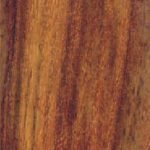
Family: Leguminosae
Other Names: Muave, muari, mucuruco.
Distribution: The species can be found in East African regions of sub-Saharan Africa. The species is distributed in the dry forest and savannas from Nigeria southward to Mozambique.
The Tree: The tree grows to a height of 50-70 ft (15.2-21.3m) with a diameter of 1-2 ft (30-60cm) with boles that average 15-20 ft (4.6-6.1m).
The Timber: The heartwood is of irregular brown color turning reddish. Its figure is handed sometimes in zigzag. Moderately lustrous. It has interlocked and wavy grain and a coarse and uneven texture.
Durability: Very durable; resistant to insects and fungal attack. Also reported as resistant to marine borers.
Workability: Resistant to saw and difficult to plane because of the grain. Resists nails and screws. Glues well. Takes a good varnish and polish.
Uses: Recommended for heavy construction, sleepers, and carpentry. Also suitable as marine timber.
9. Panga Panga
Millettia stuhlmanii

Family: Leguminosae (legume)
Other Names: Jambrie, messara.
Distribution: East Africa.
The Tree: Millettia stuhlmanii and Millettia laurentii (Wenge) come from trees of modest size, reaching 60 ft (18m) in height and logs with 1’-8” (50cm) to 2’-0” (60cm) in diameter.
The Timber: Panga Panga and wenge have similar properties; both are brown to almost black with a distinctive appearance due to lines of paler tissue. They are coarse and somewhat variable in texture, but the grain is usually straight. Both are dense woods, panga panga being 10% and wenge 20% heavier than Oak. Panga panga weighs 50 lb/ft3 (800 kg/m3) when seasoned. It is reported that Panga Panga keeps its color better than Wenge.
Seasoning: Both dry slowly and require care to avoid surface checking, but generally the degradation is minimal. The wood is stable in use.
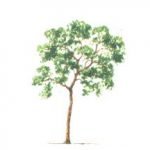
Durability: The wood is very durable; very resistant to insects and fungal attack. Sapwood is moderately permeable to preservative treatments.
Workability: Hard to saw and plane. Nails are difficult to drive and cannot be screwed without drilling. Glues well. Polishes well and takes a high varnish.
Uses: Used principally for furniture, flooring, veneer and decorative constructions.
10. Pau Ferro
Swartizia madagascariensis
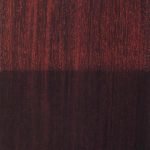
Family: Leguminosae (legume)
Other Names: Cimbe, mussacuasso, nacuata.
Distribution: Mozambique and South Africa.
The Timber: Heartwood reddish-brown with bands variable in color from yellow to dark brown. Figure caused by growth increments and in a zigzag arrangement. Little luster. Grain interlocked or wavy and texture even and fine.
Seasoning: Dries slowly without severe degrade.
Durability: Very durable: resistant to insect, fungal and termite attack.
Workability: Very difficult to saw and plane. Resistant to nails and screws with liability to splitting. Works to a fine finish. Glues well. Takes a high polish and varnish.
Uses: Heavy construction work, flooring, turnery, and carving. Sometimes is also used for furniture.
11. Pink Ivory
Berchemia zeyheri
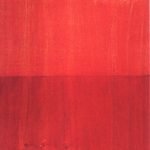
Family: Rhamnaceae (buckthorn)
Other Names: Red Ivorywood, Umnini, Umgoloti.
Distribution: Mozambique, Zimbabwe and South Africa and scattering in other parts of southern Africa.
The Tree: This is a deciduous tree with a spreading crown and varies in height from under 20 ft (6.1m0 to over 50 ft (15.2m).
The boles are usually 7-9 in. (178-229mm) in quarter girth. The flowers are small and greenish-yellow in color.
The fruits are small black berries, very similar in appearance to those of the buckthorns.
The Timber: The wood is uniformly bright pink or pale red. The luster is low, and odor and taste are not distinct.
It is hard and heavy; when air-dried the weight is 62 lb/ft3 (993 kg/m3). The grain is straight to irregular, while the texture is very fine.
The sapwood is almost white, and the pink heartwood, after long exposure, tends to become orange-colored or orange-brown.
Seasoning: Pink Ivory seasons very slowly and needs care to prevent checking.
Durability: The timber is reported to be very strong and stiff.
Workability: It is difficult to work with hand tools, but is an excellent wood for turnery and carving. It takes a high polish.
The rays are so close together they are not easily seen.
Uses: Pink ivory cannot be considered a commercial timber because the trees are scattered as to make exploitation a costly process.
The small quantities that are felled are used for fancy articles, inlaid work, small turned goods, and carving.
12. Sandalo
Spirostachys africana
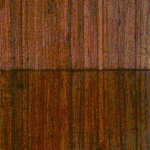
Family: Euphorbiaceae
Other Names: Sandalo africano, zunvorre, tomboti.
Distribution: Mozambique and throughout the forest of eastern Africa.
The Tree: The logs secured from this species are from 8-10 ft (2.4-3.05m) averaging 1 ft (30cm) in diameter.
The Timber: The heartwood is dark brown with darker longitudinal streaks that create beautiful markings.
Figure mottled and banded, sometimes with visible growth increments. It is a hard wood, averaging 65 lb/ft3 (1,041 kg/m3).
Lustrous and with a powerful, persistent, and pleasant scent sweeter than that of sandalwood. This pleasant odor will last a long time after the wood is cut.
A piece of furniture made of it can scent a large room for a long time.
Seasoning: Dries very slowly without distortion.
Durability: The wood is very durable; resistant to insects and fungal attack. Heartwood resistant to impregnation.
Workability: The wood is easy to saw when dried. Planes well by only in the growth increments direction.
It cannot be nailed or screwed without pre boring. Turns easily. Its oily surface makes sanding difficult. Glues slowly. Takes a high polish and varnish.
Uses: Used mostly for carving, luxury furniture, turnery, and curios.
Because of its limited quantities, and the defectiveness of the tree, it is a rare wood and therefore sought for small fancy articles and high-grade furniture.
13. Umbila
Pterocarpus angolensis
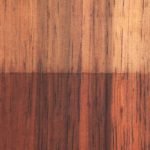
Family: Leguminosae
Other Names: Imbila, mebila, tondo.
Distribution: Tanzania, Zambia, Mozambique, Zimbabwe, and South Africa.
The Tree: The tree grows to a height of 50 ft (15m), sometimes 70 ft (21m) and a diameter of 2 ft (0.6m).
The Timber: The oatmeal-colored sapwood is clearly defined from the heartwood, which matures into a goldern-brown with irregular darker chocolate-brown stripes.
Seasoning: Dries very well. Small movement in service.
Durability: The wood is very durable; resistant to insect, fungus and marine borers.
Workability: The timber works easily with both hand and machine tools. It can be easily nailed or screwed. Works to a fine finish. Glues well. Takes a high polish and varnish.
Uses: Excellent timber used mainly for furniture, joinery and decorative veneer. Also suitable for general construction work and for marine uses.
14. Niove African Cherry
Staudia stipitata
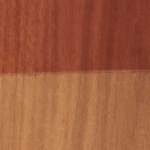
Other Names: Kamashi, Oropa, ekop.
Heartwood: The heartwood is red-brown to orange-brown with darker brown streaks.
Sanded heartwood has a color similar to Teak which when finished, with a clear water-based polyurethane finish, highlights the rich qualities of the wood and produces a wood that resembles American black cherry in color, grain, and texture.
A very attractive wood. Light sanding produces a very smooth surface.
The surface is slightly lustrous and occasionally oily. This is an excellent substitute for American Black Cherry.
Grain: Straight.
Texture: Very fine.
Specific Gravity: Green 0.75 / Dry 0.83
Weight: 830 kg/m3 (51 lb/ft3)
Seasoning: Kiln drying is advised. Drying needs to be slow to avoid checking and shakes.
Working Properties: Niove is fairly easy to work with hand and machine tools, despite its hardness.
It can be brought to a smooth finish. Nails and screws fairly well, but pre-boring is advised to avoid splitting tendencies.
Due to natural oiliness, gluing can be a problem unless the surface is properly prepared. Sands to a clean and smooth finish with good polishing capabilities.
Natural Durability In Contact With Soil: The timber is resistant to decay and insect attack.
It is durable and extremely resistant to preservative treatment. One of the best woods for exterior use.
Excellent weathering properties.
Uses: Externally in exposed conditions, such as door and window frames, external structural work, interior, and exterior joinery, cabinetwork, and heavy-duty flooring.

looking for fruit wood for cooking sake